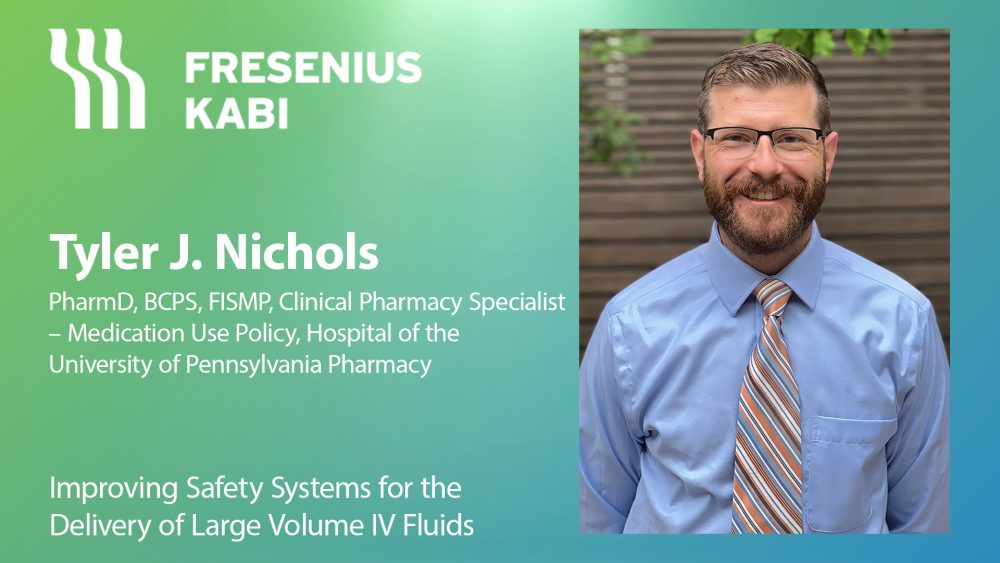Advertisment
Improving Safety Systems for the Delivery of Large Volume IV Fluids

“IV fluids are not free of risk – they’re often thought of as being benign products… but just like medication these large volume IV fluids can cause harm when used inappropriately”, said Tyler Nichols (Clinical Pharmacy Specialist – Medication Use Policy, Hospital of the University of Pennsylvania)
Inherent risks
It is important to understand that certain products are associated with inherent risks. Typically, this means that they are packaged in ways that make it difficult for users to select or use them safely or correctly. Examples of inherent risks include products with look-alike packaging and with sound-alike names, barcodes that are difficult to read or labels with product information that is confusing or hard to read.
One example was IV bags labelled prominently with the words ‘Potassium Chloride’ but the carrier fluid was named in a very small font – so that it was not easy to pick the correct product. Another example was bags of sterile water that could easily be confused with 3% sodium chloride. Both carried red-edged warning labels – one said ‘hypertonic’ and the other ‘hypotonic’ (sterile water) and could easily be mixed up, explained Dr. Nichols. “let’s be clear we never want to infuse sterile water – it causes hemolysis and, many times death”.1
Barcodes have been in use in the US for medicines since 2004. However, “Barcodes are really only great when they work”. It can be difficult for scanners to read barcodes printed on clear plastic IV bags. When it does not work, nurses are tempted to use workarounds such as “proxy scans or [use] the barcode on the bag they just took down”. This removes the protection that the barcode is supposed to offer. What is needed is a black barcode on an opaque white background, said Dr. Nichols.
Many IV bags have more information printed on front than is really necessary. Much of this is described as ‘label clutter’ by the FDA 2013 Draft Guidance for Industry and should not be included. The clutter makes it hard for users to find the information required. Furthermore, the way in which the contents are described can lead to confusion. For example, if a solute is described by concentration – grams per liter or grams per 100mL – rather than the total amount in the bag, errors can occur.
Another unexpected error can arise when simulation products used for training purposes accidentally make their way into patient care areas. In fact, in 2015, more than 40 patients received IV fluids made for use in simulation exercises and developed adverse reactions including fever, tremors and chills. At least one death was reported.2 “Normally when they make them, they are not sterile products – just tap water put into a bag”. If they are used for training, they should be kept well away from patient care areas, advised Dr. Nichols.
Acquisition risks
There may be hidden processes that we don’t think about on day-to-day basis and these processes can influence the safe use of IV fluids. Dr. Nichols recommended asking a number of questions:
- Who purchases large volume IV fluids in your hospital? IV fluids are most likely purchased through the materials management department, rather than the pharmacy, he said.
- Do you have a limited fluid formulary or do you stock every available IV fluid option?
- Are ‘custom’ fluids compounded when prescribers request them? In-house compounding of unusual concentrations is unnecessary and it increases the risk of errors.
- Is utilization of fluids monitored and reviewed for potential formulary inclusion or exclusion? Requests that don’t go through pharmacy could mean that products arrive without pharmacy’s knowledge, he noted.
- When substitutions are made, is anybody within pharmacy or medication safety groups made aware of this?
- Who ensures that barcodes are correctly linked in systems? Manufacturer barcodes may be automatically recognizable in your electronic health record based on imported data sets, but is this ever validated? Is pharmacy involved in process?
Dr. Nichols recommended working closely with Materials Management departments to manage purchasing of IV fluids pro-actively.
One example of the type of problem that can occur was when a hospital emergency department ran out of vials of sterile water [for injection]. The Materials Management department supplied two-liter bags of sterile water to reconstitute antibiotic injections. On this occasion the large volume bags were intercepted and removed by an Emergency Department pharmacist. “There are multiple reasons why you don’t want to hang a two-liter bag and just pull off diluent throughout the day…” There are contamination risks and also the risk of accidental administration. “Having [large volume] sterile water [for injections] on patient care units is a danger… two-liter bags are only for pharmacy compounding”, said Dr. Nichols.3
Another example was when a respiratory therapist reported that bottles of sterile water for irrigation were leaking. They were replaced with one-liter bags of sterile water that were later found in the ward’s IV fluid storage bins. Large volume bags in overwraps look similar and these could have been administered intravenously by mistake, explained Dr. Nichols.4
Storage
Proper storage of IV fluids is important because poor (chaotic or cramped) storage conditions can contribute to picking errors and the accidental administration of incorrect fluids. Although stock levels are often maintained by the Materials Management department, Dr. Nichols recommended that pharmacists should be involved in regular inspections of fluid storage locations to ensure that opportunities for mix-ups are minimized. They should also bear in mind that wards may have devised additional storage spaces, for example in clean utility areas, he added.
Prescribing and verification
Dr. Nichols described one example of poor prescribing that started a train of events that eventually led to the death of a patient. A physician wrote an order (prescription) for “free water” for a patient with hypernatremia and also called the pharmacy to enquire whether they stocked large volume bags of sterile water. A pharmacist entered the order for the 2,000 mL bag of water [for injection]; an intern retrieved the bag from the sterile compounding area, placed the label on the back of the bag and dispensed it to the ICU. The nurse did not see the warning, ‘Pharmacy Bulk Package, Not for Direct Infusion’, because the label was on the back of the bag and not the front. The error was identified after 550 mL had been infused. However, the patient experienced a hemolytic reaction, acute renal failure, and ultimately died.5
This case underlined some of the key points for safe prescribing and verification of orders. Dr. Nichols suggested that the following points should be included in safe systems:
- Clinically appropriate large volume IV fluids should be included in order sets and protocols
- Product names/naming conventions should be consistent through the institution (i.e. for acquisition, storage locations, computerized physician order systems, smart infusion pumps etc)
- Decisions on naming conventions should include providers from different disciplines
- Electronic health records should prompt providers with appropriate clinical alerts (e.g., fluid order duplication, excessive infusion rates) and avoid excessive alerting that could lead to ‘alert fatigue’.
- Pharmacists should verify large volume IV fluid orders and the use of automatic verification should be limited (e.g. to low-risk situations)
- Pharmacists should be adequately trained in the use of intravenous fluids so that they are able to verify large volume IV fluid orders competently
Administration & Documentation
Smart IV pumps were introduced to reduce errors including those due to incorrect programming, incorrect dosage selection and accidental free-flow. In surveys conducted by the Institute for Safe Medication Practices (ISMP) between 2017 and 2018 a number of potential safety gaps were identified. These included:
- Insufficient pumps available when hospital occupancy was high
- 45% of nurses reported programming of IV fluids as a basic infusion without the use of the library more than 50% of the time.
- Barriers included IV fluids not being listed in the drug library (45%), perceived lengthy process for programming IV fluids through the drug library (19%), and a lack of hospital policy establishing expectations to use the drug library for IV fluids (10%).
The ISMP had issued guidelines for the use of smart pumps in 2020, noted Dr. Nichols. (ISMP Guidelines for Optimizing Safe Implementation and Use of Smart Infusion Pumps. ISMP; 2020. https://www.ismp.org/node/972)
Dr. Nichols concluded with a series of recommendations:
Recommendations
- Evaluate current large volume IV fluid supply and stock for potential safety risks.
- Advocate for pharmacy involvement in value analysis or purchasing groups outside of pharmacy.
- Include clean utility rooms in regular pharmacy unit-based inspections.
- Develop an interdisciplinary team to evaluate how large volume IV fluids are represented across all systems.
- Evaluate how fluids and appropriate warnings appear in electronic health records and medication administration records for different types of providers.
- Involve IV fluid stewardship teams in the development of appropriate smart pump infusion library builds for large volume IV fluids and associated guardrails.
- Establish organizational expectations for use of auto-programming and dosage error reduction software (DERS) with the goal to maximize practitioner compliance to 95% or greater for the administration of IV fluid infusions and monitor CQI data to identify and address barriers.
- Establish that the use of smart infusion pump technology is the expected practice throughout the organization, including in ambulatory settings such as perioperative/procedural/radiology areas, the emergency department, and infusion centers for the administration of all IV fluid infusions.
- Monitor barcode scanning data related to large volume IV infusions to ensure compliance and to identify and address any potential product or process issues.
- Ensure that staff education includes an understanding of the risks associated with large volume IV infusions, and the benefits of using appropriate technologies.
- Ensure staff awareness of the risk of free-flow events and misconnections and the protocols in place to help prevent occurrence.
References
- Institute for Safe Medication Practices (ISMP). Errors continue with unsafe B. Braun IV bag labeling and difficult-to-scan barcodes. ISMP Medication Safety Alert! 2023;28(11):2-5. https://www.ismp.org/sites/default/files/newsletter-issues/20210211.pdf
- Institute for Safe Medication Practices (ISMP). Simulation products look real. ISMP Medication Safety Alert! 2018;23(24):1-3. https://www.ismp.org/sites/default/files/attachments/2018-11/20181129.pdf
- Institute for Safe Medication Practices (ISMP). Handling of sterile water bags by materials management increases risk. 2018;23(7):3. https://www.ismp.org/sites/default/files/attachments/2018-04/20180405.pdf
- ISMP Medication Safety Alert. Safety considerations during expedited product approval. Acute Care; April 6, 2023 Volume 28 Issue 7 https://www.ismp.org/sites/default/files/newsletter-issues/20230406.pdf
- “ISMP_Water, Water, Everywhere, But Please Don’t IV_2023-01-23_REF-4758” https://www.ismp.org/resources/water-water-everywhere-please-dont-give-iv
 |
Based on a presentation given by Dr. Tyler J Nichols at a Fresenius Kabi satellite symposium held at the ASHP Midyear Clinical Meeting 3-7th December 2023. |
About Tyler J Nichols
Tyler received his Doctor of Pharmacy Degree from Albany College of Pharmacy and Health Sciences in Albany, NY in 2010 and his board certification in pharmacotherapy in 2016. He recently transitioned into his current role as a clinical pharmacy specialist in medication use policy at the Hospital of the University of Pennsylvania after completing a one-year fellowship in medication safety with the Institute for Safe Medication Practices. Prior to that he spent 12 years occupying various roles in health-systems pharmacy including clinical-staff pharmacist, medication safety officer and pharmacy supervisor with a focus on sterile product preparations.
<Back to Fresenius Kabi IV Fluid Stewardship Program homepage>





